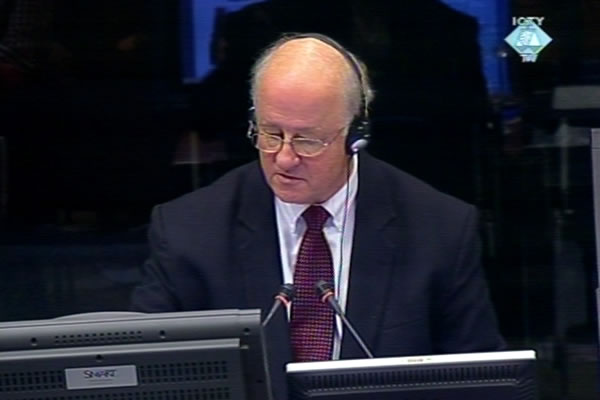Home
DESTROYING CULTURAL HERITAGE
US expert for the Ottoman cultural heritage Andras Riedlmayer testified at the trial of Radovan Karadzic about the destruction of Muslim and Catholic cultural and religious buildings during the war in BH. The sites where mosques and churches used to stand were turned into parking lots, flea markets or garbage tips. According to Karadzic, the Bosnian Serb authorities were not to blame for the destruction: it was the consequence of the ‘chaos of a civil war which engenders more chaos’
 Andras Riedlmayer, witness at the Radovan Karadzic trial
Andras Riedlmayer, witness at the Radovan Karadzic trial American expert for the Ottoman cultural heritage Andras Riedlmayer used photographs to show the degree of destruction of the Muslim and Catholic religious buildings in the municipalities controlled by the Republika Srpska Army (VRS). Some of the buildings suffered varying degrees of damage, but some were almost or completely destroyed. In many cases, all evidence of their existence was destroyed: the sites where they used to stand were turned into parking lots, flea markets or garbage tips.
Among the cultural and religious buildings that were completely destroyed, Riedlmayer listed the parish church in Kljuc, the town mosque in Rogatica, the Kozarusa mosque in Prijedor, the Aladza mosque in Foca, and many others, including the mosque of the Sultan Mehmed the Conqueror in Zvornik. The mosque stood on a steep ridge, about two hours’ walk on very rugged terrain, which goes to show how much effort was put into the destruction of the mosque.
Riedlmayer visited 281 sites in BH where mosques and other Muslim religious buildings used to stand. He found that 266 of buildings suffered major damage or were almost or completely destroyed. The same degree of damage was noted in 32 of the 42 Roman Catholic buildings visited by the US expert. He noted that a map on which the sites of the damaged or destroyed buildings were marked would closely correspond to the territory controlled by the Bosnian Serb forces.
In the cross-examination, Karadzic tried to discredit Riedlmayer’s expertise and impartiality, arguing that as a whole the US expert was only interested in trials of Serbs and Serbia. Karadzic put it to the witness several times that he ‘expressed regret that Serbia was not found guilty of genocide in Bosnia’. Riedlmayer said he was in fact a witness for BH in the proceedings against Serbia and Montenegro before the International Court of Justice, stressing, ‘As far as I can recall, the Court established that Serbia had violated the Genocide Convention by failing to prevent or punish the genocide in Bosnia’. He could not recall if he had expressed regret over the fact that the judgment ‘did not go beyond that’, but as he insisted, it would have been ‘good’ if it had.
Challenging the witness’s impartiality, Karadzic brought up the petition for his and Mladic’s arrest signed by Riedlmayer and thousands of other people, and a text Riedlmayer wrote in 1993, A Short History of BH, advocating the lifting of the arms embargo on the Muslims’. Riedlmayer did not deny it, saying BH as a UN member state was entitled to self-defense.
Karadzic put it to Riedlmayer that he did not take into account ‘the chaos of a civil war which engenders more chaos’ when he wrote his report. As Karadzic said, the witness did not take into account that there had been fighting near the damaged buildings. He claimed on the one hand that the Muslims used mosques as recruitment centers and weapon distribution posts, and minarets as sniper and machine gun nests. On the other, he argued that the civilian and military authorities in Republika Srpska had nothing to do with their destruction and that they worked hard to protect them and prosecute the prosecutors. Karadzic blames the paramilitaries and Serb refugees who had fled the areas where Muslims and Croats destroyed Serb places of worship for the destruction of Muslim religious buildings.
Based on the traces on the remains of the damaged or destroyed cultural and religious buildings, the prosecution expert said, one could conclude that they were not destroyed in the fighting. Quite the contrary: some buildings were quite obviously damaged by explosive or fire, and then razed to the ground with bulldozers. As the witness said, many buildings were destroyed after the Serbs took over power. An example was the mosque in Bijeljina which was destroyed in the spring of 1993. At that time, the town had been under the VRS control for almost a year.
Riedlmayer noted it was his job to establish the facts about the degree of destruction inflicted on the Muslim and Catholic cultural and religious buildings; it is up to the Trial Chamber to establish who is responsible for the damage.
Radovan Karadzic’s trial will continue after the winter recess, on 10 January 2012.
Linked Reports
- Case : Karadzic
- 2011-12-08 FIGHTERS WITH BLINDFOLDS AND THEIR HANDS TIED
- 2011-12-02 ANTHROPOLOGICAL EVIDENCE FROM MASS GRAVES
- 2011-12-01 EVIDENCE FROM MASS GRAVES
- 2012-01-10 SURVIVOR FROM PETKOVCI DAM GIVES EVIDENCE
- 2012-01-11 KARADZIC DENIES MASS EXECUTIONS
- 2012-01-12 WITNESS: SERB OFFICERS TOLD US THEY WANTED SREBRENICA FOR THEMSELVES
